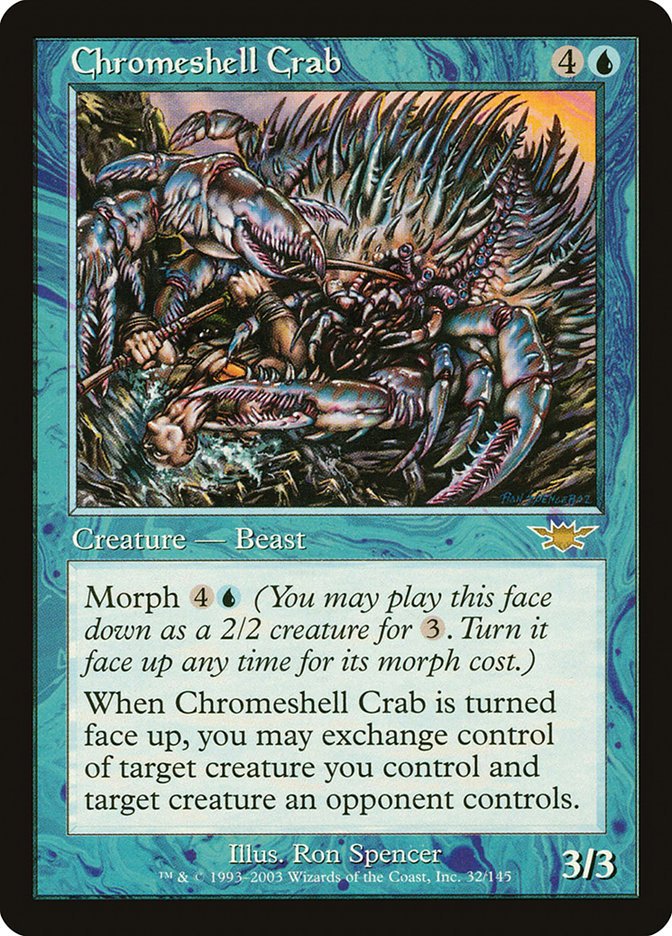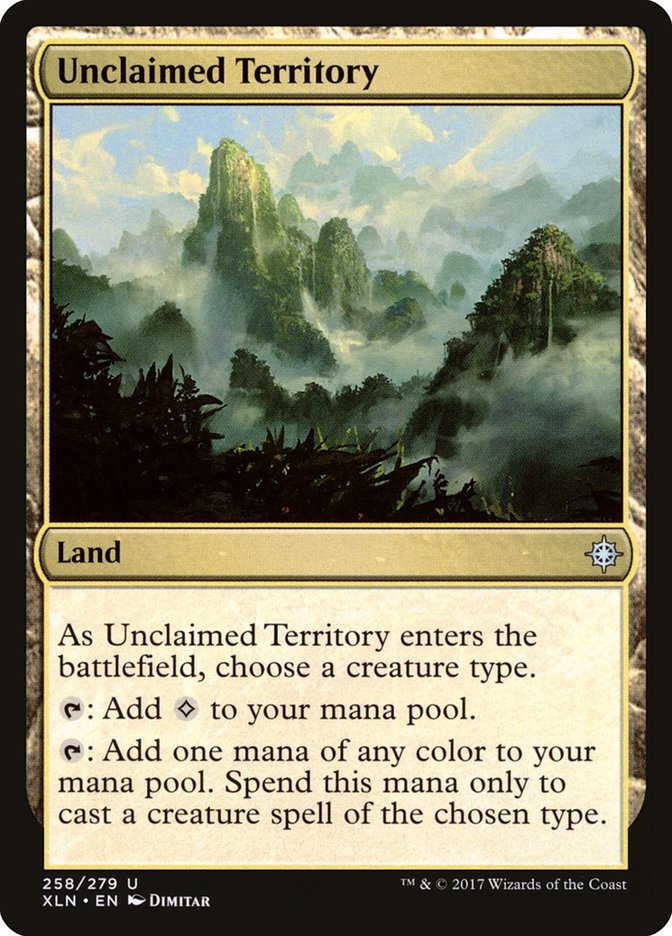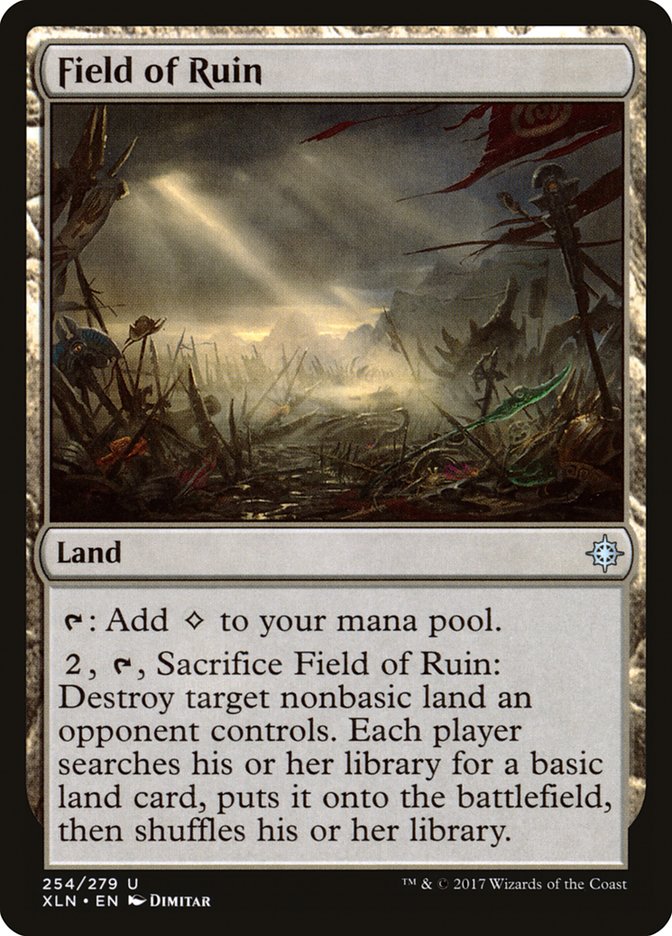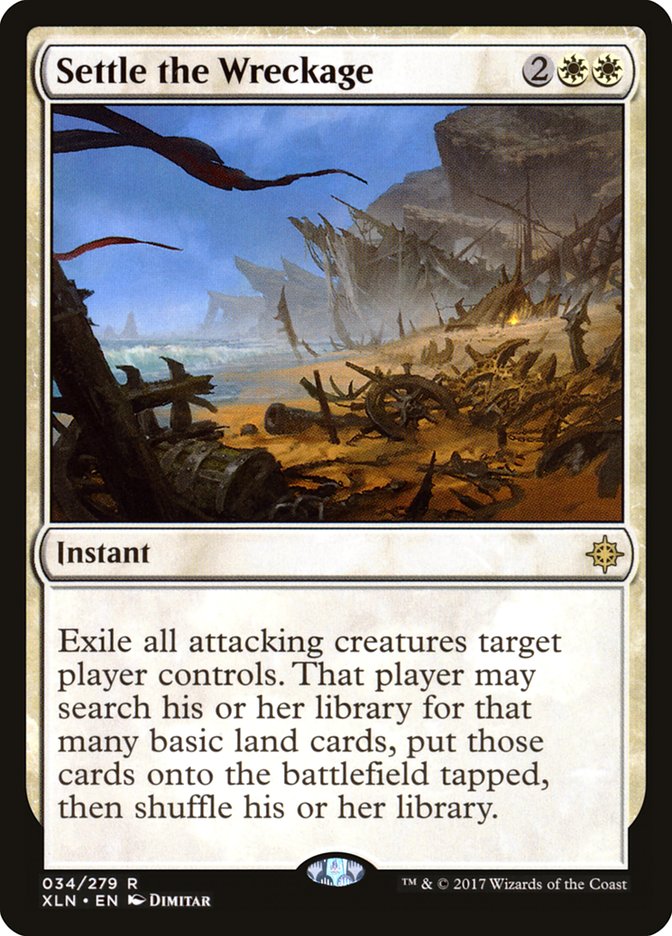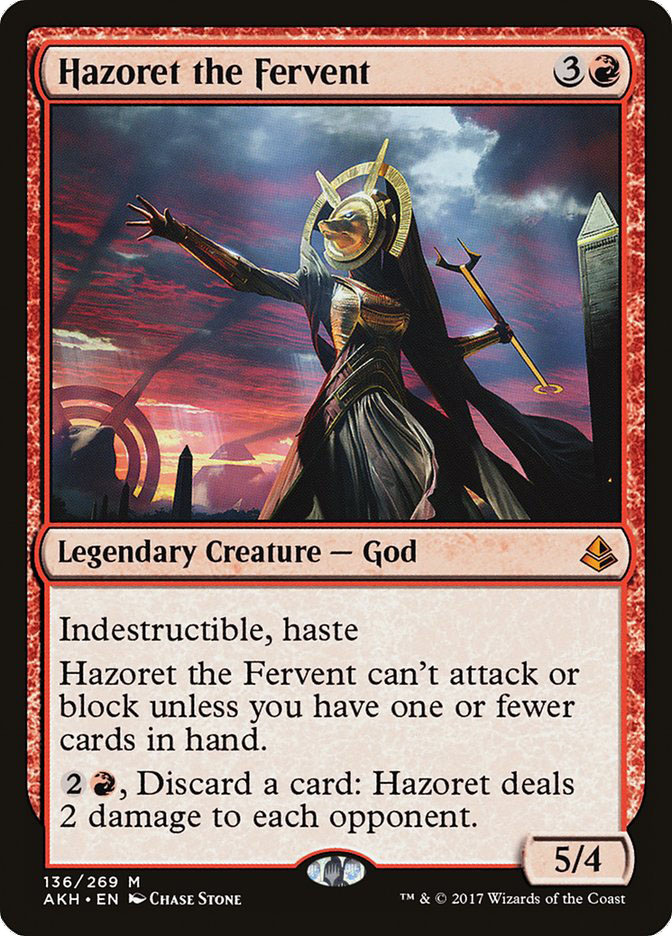Historically, preconstructed Magic decks have been awful.
As a kid, buying a worthless preconstructed deck was almost a rite of
passage. Your $10 bill bought you a 60-card monstrosity with a name like
Call of the Kor, One-Two Punch, or Trounce-O-Matic. You brought it to
school the next day, and immediately got run over by anybody who spent even
a modicum of effort tuning their deck.
It wasn’t like we were even playing with top tier Standard cards or
anything-beating these old preconstructed decks was just so trivial.
They’ve gotten a bit better since the days of Chromeshell Crab, but if you
take even a modified version of one of these decks to FNM you will probably
go home with all of the losses you could ever want.
WotC has stepped up their game a few times over the years, but never with
any consistency. There was a pretty decent B/W Tokens Modern Event Deck a
while back, Windswept Heath was in a precon, and I bought a few copies of
that Magic: Origins deck with Tasigur, the Golden Fang and
Hangarback Walker. The current Commander series is pretty good, too. Based
on the current crop of preconstructed planeswalker decks that are still out
there, I certainly didn’t expect WotC’s Challenger Decks to be much more
than a 4-5 decent rares surrounded by a sea of decent commons and
uncommons.
What we got instead were pretty solid versions of Mono-Red Aggro, Mardu
Vehicles, U/W Approach, and G/B Constrictor. These are real decks full of
real staples, and if you took one to FNM unmodified, you might actually win
a couple of matches. Was paying $100-$300 to play Standard too much? How
about $29.99 plus tax?
This changes everything.
Let’s talk about the long-term implications of this. First, I would be
shocked if these decks don’t end up meaningfully increasing the number of
Magic players who are actively engaged with Standard at any given time.
There are a whole lot of semi-competitive players who jump in and out of
the format based on whether or not it seems good enough to warrant dropping
a bunch of money on a deck. Until now, WotC’s best move has always been to
ensure that the Standard environment was good enough that you felt like you
were missing out if you didn’t buy in. That’s been harder for them to
accomplish in recent months, though, and Standard has taken a backseat to
Modern in the eyes of many players.
If you can legitimately play Standard for 30 bucks, though, the bar for
“this Standard format is good enough for me to engage with” becomes a heck
of a lot lower. If I’m spending $300 on a deck, I want to be sure that I
can get at least 40-50 hours of entertainment out of it. On the other hand,
I’ll happily drop $30 on a fun evening out. Thanks to the Challenger Decks,
the chances of people making an “ah, screw it, I’ll buy one of these and
play FNM tonight” purchase is so much higher now.
These decks also provide new and returning players with a reasonable
on-ramp to Standard for the first time ever.
This recent Polygon article
is a great example of why this is so necessary-the reporter goes from
Welcome Deck to Planeswalker Deck to Deckbuilder’s Toolkit…and then
proceeds to lose every game at his first FNM. At that point, he’s spent $50
and has almost zero cards that are actually going to be useful in any sort
of competitive format. If his LGS had had a stack of these Challenger
Decks, it would have been an entirely different story.
An increase in the size of the Standard player base usually leads to an
increase in prices, but that surge should be counteracted by the fact that
these Challenger Decks are going to make a lot of important staples much
cheaper. In fact, I suspect that the Standard metagame will have more or
less the same overall value going forward, with the caveat that a small
group of previously expensive cards will become a lot cheaper while larger
group of cards will become a little more expensive.
Does this mean that we now have to walk on eggshells when speculating on
Standard cards? Not quite. One of the nice things about these decks is that
most of the expensive cards are from Amonkhet and Kaladesh blocks. If you spent a bunch of money on Chandras or
Hazorets or Hearts of Kiran, you’ve had plenty of time to reap those
rewards. The most expensive cards from Ixalan in these decks?
Unclaimed Territory, Field of Ruin, and a single copy of Settle the
Wreckage.
This is not an accident. WotC does not want to cannibalize sales of their
latest set, so you’re probably never going to see the latest and greatest
chase mythics in these Challenger Decks. They know that we’re not really
buying Amonkhet and Kaladesh packs anymore, though, so
they can wring a little bit more value out of those cards by selling them
directly to us here. Just like the Masters sets, WotC is doing
their best to cash in on the secondary market value of their cards in
whatever way possible. (This isn’t necessary a bad thing. I’m a big fan of
the Challenger Decks!)
What does this mean for us in terms of Standard speculation going forward?
Well, these types of reprints are an additional pitfall to consider when
holding onto our Standard cards for longer than a year. The problem is that
we might be able to guess at what next year’s Challenger Decks will
include, but getting it right is going to be very difficult. The Scarab God
seems like it would have been the perfect inclusion this time around, for
example, but it’s nowhere to be seen. The upshot is that holding onto $4-$5
cards from the second-to-last block is now a bit riskier, but I don’t think
I’ll actually change my speculation behavior all that much. Standard moves
so fast that you never really know what is going to bring a card like
Glint-Sleeve Siphoner from $0.50 to $5 and back again regardless of these
reprints. You shouldn’t be holding onto cards like this for long enough to
get blown out.
As for long-term speculation, it’s likely that the cards in these
decks-particularly the cards being printed as three and four-ofs-will lag
behind the curve when it comes to gaining ground down the line. This sort
of speculation has become a lot more difficult in recent years regardless,
though, and there are only a small handful of cards from the past few years
that have gained or maintained value after rotation anyway. Again, I’m
probably not going to change what I do in any meaningful way, but these
printings are worth keeping this in mind if, say, Harsh Mentor ends up
becoming a fringe player in a new Modern deck. Demand will have to get
really, really high before we run through any available supply of those
now.
I’m much more interested in what happens to demand in the short term. I’d
love to tell you exactly how much value Hazoret the Fervent is about to
lose, but I don’t have enough information to make a numerical prediction
yet. For one, we don’t know how prevalent these Challenger Decks are going
to be. Will they be exclusive to local shops, or will you be able to walk
into Wal-Mart and buy one at any hour of the day or night? Will they be
printed in such high quantities that your local metagame will be saturated,
or will some jerk buy the only four copies of the best deck right away, the
expected re-stock never comes, and then we all forget about them until the
next batch are previewed? My hope-and expectation-is that these decks will
be everywhere, but it’s too early to say for sure.
The biggest thing to pay attention to is whether or not the singles in each
of these decks can sustain an overall secondary market value at or above
MSRP. If it’s fairly easy to get the Hazoret Aggro deck for $30, there’s no
way that Hazoret the Fervent and Chandra, Torch of Defiance can sustain a
price tag of even $25 between the two of them. If these decks are a bit
more scarce, however, then we’ll get some depreciation but not the full
amount. Some of the past Commander decks have been able to sustain a value
of roughly 160-175% of their retail value while still in print-just enough
so that you might make a couple of bucks splitting up the deck and
buylisting the singles, but not enough to make the act actually worth it.
The good news for those of you hoping that all of these cards don’t
completely tank is that a whole lot of people are going to buy these decks
and just…use them. I’d wager that almost everybody who bought the Rat’s
Nest precon back in Betrayers of Kamigawa immediately pulled out
the Umezawa’s Jitte and threw the rest of the cards in a drawer forever,
which lead to a lot more loose Jittes floating around the marketplace. If
most people who buy these decks end up using them, however, it’s going to
raise demand for the cards that are only included in small quantities in
these decks.
Because of this, my gut feeling is that some people might be surprised at
which of these freshly-reprinted cards lose 80% of their current value and
which only lose 10-20%. For example, the Hazoret deck has 3-4 copies of
Soul-Scar Mage and Bomat Courier but only one copy each of Chandra, Torch
of Defiance and Hazoret the Fervent. Nobody who buys this deck is going to
need another copy of Soul-Scar Mage or Bomat Courier, but all of them will
want at least 1-2 more copies of Hazoret. And yeah, Bomat Courier is
already a far cheaper card than Hazoret, but some of these three and
four-ofs are going to be dropping toward total bulk while demand for some
of the one-ofs is going to remain high, even if its price tag drops a bit.
Of course, the biggest gainers are going to be the cards that weren’t
included-the staples that the players who buy a Challenger Deck are going
to be after at the trade tables once they get a taste of high level
competition. My advice? Grab some of these now, before the Challenger Decks
hit shelves. Even if U/W Approach isn’t the best deck in the format a few
weeks from now, I can’t imagine there won’t be demand from the folks who
are going to want to tune their $30 deck into a slightly better version of
itself.
Let’s go through each deck one at a time:
Counter Surge
Financially Relevant Inclusions:
-
Glint-Sleeve Siphoner x4 – $20
-
Verdurous Gearhulk x3 – $15
-
Walking Ballista – $13
-
Fatal Push – $9
-
Aether Hub x4 – $5
-
Rishkar, Peema Renegade x3 – $3.75
-
Lifecrafter’s Bestiary – $2.50
-
Scrapheap Scrounger x2 – $2
Total Value: $70.25
This is the G/B Constrictor list, and you’re paying about 43 cents on the
dollar for these cards if you snag the deck at MSRP. I expect the biggest
price drops will come from Glint-Sleeve Siphoner, Verdurous Gearhulk,
Aether Hub, and Rishkar, Peema Renegade, none of which should be in very
high demand at all after this deck hits shelves. On the other hand, Fatal
Push and Walking Ballista shouldn’t lose much value at all – there’s only
one copy of each here, and you’ll need to buy additional copies if you want
to optimize this deck for tournament play.
Financially Relevant Additions:
-
Vraska’s Contempt x3 – $54
-
Jadelight Ranger x4 – $52
-
Walking Ballista x2 – $26
-
Blooming Marsh x4 – $26
-
Fatal Push x2 – $18
-
Vraska, Relic Seeker – $14
-
Deathgorge Scavenger x3 – $10.50
-
Aethersphere Harvester x2 – $6
-
Merfolk Branchwalker x3 – $4.50
Total Cost: $211
You’ll still need to put a lot of money into this deck if you really want
to optimize it. The most important inclusions-and the cards most likely to
see an increase in demand due to this deck-are the Vraska’s Contempts and
the Jadelight Rangers. Vraska’s Contempt is pretty close to its price
ceiling already, though, and Jadelight Ranger isn’t too far off. I might
consider trading for these, but I don’t think the price will rise enough to
make a spec buy worth it. I’m not sure this is the preconstructed deck you
should pick up if you’re interested in turning it into a tier one brew
anyhow.
Hazoret Aggro
Financially Relevant Inclusions:
-
Hazoret the Fervent – $25
-
Soul-Scar Mage x3 – $9
-
Bomat Courier x4 – $5
-
Glorybringer – $4
-
Kari Zev, Skyship Raider x3 – $3.75
-
Harsh Mentor x3 – $3
-
Abrade x2 – $3
Total Value: $82.75
Can you believe that the deck with Chandra and Hazoret is the second-worst
in terms of current retail value? It’s true! You’re getting the two most
expensive cards here, though, and I expect this to be the go-to deck of the
batch. Not only is Mono-Red Aggro the most popular deck in Standard right
now, but I expect this precon to be worth the most once the prices all drop
to cover the existence of these decks.
Like I said earlier, expect demand for Soul-Scar Mage, Bomat Courier, Kari
Zev, Skyship Raider, and Harsh Mentor to pretty much disappear. I can’t
really speak to what will happen to Chandra and Hazoret yet without knowing
more about how easy these decks will be to find. They will drop in price,
but perhaps not as much as you think.
Financially Relevant Additions:
-
Hazoret the Fervent x3 – $75
-
Earthshaker Khenra x4 – $8
-
Aethersphere Harvester x2 – $6
-
Scavenger Grounds – $2.50
Total Cost: $91.50
Oh, hey, here’s another reason why this deck is going to be in such high
demand. Other than the three other copies of Hazoret the Fervent, you only
have to dump another $20 or so into this deck to make it tier one. I wonder
if increased Hazoret demand due to people modifying this list will create a
situation where Chandra ends up dropping in price more than the Amonkhet God does. Also, get your Earthshaker Khenras, like,
yesterday. Demand for them is about to skyrocket, and I doubt they’ll be
under $5-$6 for long.
Vehicle Rush
Financially Relevant Inclusions:
-
Spire of Industry x4 – $16
-
Unclaimed Territory x3 – $15
-
Heart of Kiran x4 – $12
-
Concealed Courtyard – $6.50
-
Aethersphere Harvester x2 – $6
-
Bomat Courier x4 – $5
-
Inspiring Vantage – $4.50
-
Toolcraft Exemplar x4 – $4
-
Scrapheap Scrounger x4 – $4
-
Aether Hub x3 – $3.75
-
Dragonskull Summit – $3.50
-
Harsh Mentor x3 – $3
-
Cast Out – $2
-
Skysovereign, Consul Flagship – $1.50
Total Value: $86.75
The value in this deck is much more spread out than in Hazoret Aggro, but
it’s still quite good. I had really been liking Spire of Industry as a
long-term Modern buy, but that spec is toast now. Ditto for Heart of Kiran,
which looked like a great Commander hold before this. Unclaimed Territory
should drop a bunch, too, and don’t expect any rebounds for Toolcraft
Exemplar or Scrapheap Scrounger. Concealed Courtyard and Inspiring Vantage
should be more or less fine, though.
Financially Relevant Additions:
-
Hazoret the Fervent x3 – $75
-
Chandra, Torch of Defiance x2 – $60
-
Gideon of the Trials x2 – $22
-
Concealed Courtyard x3 – $19.50
-
Settle the Wreckage x2 – $15
-
Inspiring Vantage x3 – $13.50
-
Walking Ballista – $13
-
Canyon Slough x2 – $9
-
Authority of the Consuls x2 – $6.50
-
Fumigate – $3.50
-
Scavenger Grounds – $2.50
Total Cost: $239.50
Yowza! Tuning this deck is going to cost a lot, and your best bet is
probably going to involve buying a couple of Hazoret Aggro decks to mine
for the two Chandras and two of the Hazorets. Even after that, you’re going
to need some lands and a few other key staples. Much like with the G/B
Constrictor list, my guess is that this one doesn’t get optimized quite as
much as the other two will. You might want to consider snagging Gideon of
the Trials regardless, though. I like that it sees Modern play, though
we’ll see if that continues now that Jace, the Mind Sculptor is back.
Second Sun Control
Financially Relevant Inclusions:
-
Irrigated Farmland x4 – $24
-
Field of Ruin x2 – $12
-
Regal Caracal x4 – $12
-
Fumigate x3 – $10.50
-
Cast Out x4 – $8
-
Settle the Wreckage – $7.50
-
Censor x4 – $7
-
Approach of the Second Sun x3 – $5.25
-
Kefnet the Mindful x2 – $4
Total Value: $90.25
Thanks to the lands that come with it, the U/W Approach pre-con is actually
the best value of the bunch-you’re paying just thirty three cents on the
dollar for these cards at current MSRP. These staples will drop a lot lower
than Hazoret and Chandra will, though, and I suspect that Irrigated
Farmland, Field of Ruin, Regal Caracal, Fumigate, Cast Out, Censor, and
Approach of the Second Sun will all lose between 60-70% of their current
price tags. This might end up being the worst of the four in terms of
long-term value, but it’s still totally worth it for anyone who wants to
actually sleeve up the deck and play it.
Financially Relevant Additions:
-
Search for Azcanta x2 – $50
-
Torrential Gearhulk x2 – $28
-
Glacial Fortress x4 – $17
-
Settle the Wreckage x2 – $15
-
Authority of the Consuls x4 – $13
- Disallow x2 – $13
-
Gideon of the Trials x1 – $11
-
Scavenger Grounds x2 – $5
Total Cost: $152
I’m not sure how many people are realistically going to put another $150
into this deck, especially since it’s not even high up on the metagame’s
second tier right now, but what I like about this list is that you don’t
have to buy a single card over $25 to modify it. A lot of the pricy stuff
is either for its two-color manabase, which you can cheat, or its
sideboard, which you can tweak. Again, people are going to be after Search
for Azcanta, but what else is new? I doubt that one can go much higher
regardless. Torrential Gearhulk should see another short-term surge in
demand, though, and it might end up heading back toward $20 for a bit.
After taking a look at all of these lists, I’m impressed at how well WotC
did creating totally playable, non-embarrassing precons without hurting the
values of our Standard collections all that much. I see no reason to rush
out and buy up all of the Challenger Decks I see at MSRP, but I’m
absolutely going to pick up a couple for myself and I’m going to recommend
them to all of my friends who love Standard but aren’t currently playing
it. Want the cheapest path to a good deck? Go buy a playset of Earthshaker
Khenra now and snag a Hazoret Aggro deck as soon as it’s released. There
will probably be at least a small window where you can crack that Hazoret
deck and make an immediate profit, too, but it might close pretty quickly
if WotC prints these at the rate I’d like them to.
Beyond that, we just have to wait and see whether this ends up being a fun
curiosity or the beginning of Standard’s resurgence. Here’s hoping!
This Week’s Trends
There wasn’t too much movement in Standard this week. Rekindling Phoenix
and Vraska’s Contempt continue to tick up a bit, while Kumena, Tyrant of
Orazca and Chandra, Torch of Defiance are starting to tick down. No card
gained or lost more than about $2 this week, though. People are still
focused on Modern in the wake of the crazy unbannings.
Speaking of Modern, it was yet another week full of excitement. Liliana of
the Veil was the biggest gainer of the week, surging almost $15. Snapcaster
Mage, Dark Confidant, Tarmogoyf, and Cryptic Command are all on the rise as
well. Last week, all the “cute” specs popped off. This week, it was the
meat and potatoes staples for Jund and blue-based control decks.
The most interesting spike of the week was probably Trinisphere, which
broke $25 as people plot against cascade and cheap Jace enablers. I’m not
sure how good this is, but the card has only been printed once (twice if
you count From the Vault) and a $20+ price tag is more than
reasonable at this point.
A couple of Modern cards lost money, but it was really just stuff like
Blackcleave Cliffs and Celestial Colonnade leveling off after last week’s
helium. Both cards stabilized a bit higher than I thought they would, and I
don’t think we’ve started to see the crazy Modern drops that will come once
Jace, the Mind Sculptor chases a bunch of decks out of the format. We’re
not in a bubble right now, but we are in a boom.
Late last week, WotC released an article called
The Future of Masters
that told us…well, almost nothing about the future of the Masters sets. The
most interesting thing we learned was that format-based Masters sets like Modern Masters and Eternal Masters are dead, and the
future will include more sets like Iconic Masters and Masters 25. This seems misguided to me, since the whole purpose of
spending $10 on a pack is to get a good chance of a card you want to open.
By trying to make these sets for everybody at once, WotC thinks that it
means more people are going to be compelled to buy packs. Instead, it
really just means that nobody is going to want to buy packs and everyone
will just wait and buy the singles they want on the secondary market, like
they did with Iconic Masters.
I suppose they could get around this by lowering the MSRP (unlikely),
printing fewer Masters sets so they feel more special (unlikely), or
jamming so much value into each set that you can’t help but feel compelled
to buy packs (unsustainable). We’ll see, I guess. I’ve been bearish on how
WotC has been handling the Masters series for a couple of years now, and
nothing in that article changed my mind about that. Oh well-at least the
Challenger Decks are cool.


